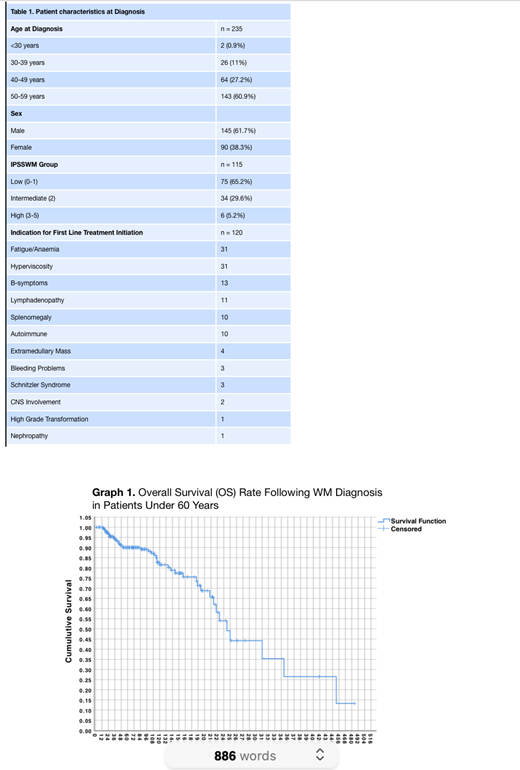Introduction
Waldenström's macroglobulinaemia (WM), an indolent IgM-secreting non-Hodgkin's B-cell lymphoplasmacytic lymphoma, has a reported average age of diagnosis of 65-70 years. and it is often regarded as a disease of the elderly. However, a significant proportion of patients are diagnosed at a younger age and data about this cohort is relatively limited, partly because of the low disease incidence. We seek to further elucidate the characteristics and impact of the disease in the younger patient cohort.
Methods
The WMUK Rory Morrison Registry (RMR) was searched for all patients younger than 60 years on day of diagnosis. Demographics, disease characteristics, treatment information and survival status were collected retrospectively. Results of patient reported outcome measures (PROMs) were collated.
Results
269 patients from 16 UK centres were identified, with years of diagnosis between 1978 and 2018. Analysis focused on 235 patients who fulfilled diagnostic criteria for WM. Patient characteristics are shown in table 1. M:F ratio was 1.61:1 of which 158 patients were Caucasian, 17 Asian, 5 Black, 3 mixed and 6 of other ethnicity, 56 unrecorded. Bone marrow results were available in 156 patients from time of diagnosis, with a median infiltration of 40%. MYD88 L265P was found in 61/74 patients (82.4%) and CXCR4 mutation in 14/39 patients (35.9%). Median Hb was 114/L (range 33-170), platelet count 250x109/L (range 24-689), IgM 19 (range 0-65) and B2-microglobulin 2.7mcg/mL (range 0.5-56.3). The baseline IPSSWM scores were available for 115 patients. 9 patients were anti-MAG antibody positive and 11 had cryoglobulins.
Treatment was received by 164 patients (69.8%). The median time from diagnosis to treatment was 2.5 months, range 0-312 months; 69 patients had one line, 32 two lines, 31 three lines, 12 four lines, and 20 five or more lines.14% received R-CHOP as first line therapy, 12.2% DRC,12.2% R-Bendamustine, 7.3% Rituximab monotherapy, 6.7% R-CVP and 6.7% chlorambucil. However, since 2010 DRC and R-Bendamustine were the most frequent. Following first line treatment, 14.7% achieved CR, 55.3% PR or VGPR, 11.9% MR and 14% had SD or PD. At some point in their disease course, high-grade transformation (HGT) was noted in 2 patients and CNS involvement in 10. 30 patients had undergone autologous and six patients allogenic transplantation.
Complete, up to date survival information was available for 188 patients, of who 40 patients were deceased (median time from diagnosis 116 months, range 14-451 months). Unfortunately, cause of death was available for only 8 patients at time of analysis, including disease-related in 4, sepsis in 2, HGT in 1 and subdural haemorrhage in 1. One-, 5- and 10-year overall survival (OS) rates were 99.5%, 90% and 81.1%. There was a significant difference in OS according to IPSSWM risk (log rank, P <0.005), with a 5-year OS rate of 92.% for the low risk, 79% for the intermediate, and 38% for the high risk group. There was no significant difference in OS rates according to age group.
Of 164 patients asked about their level of disease understanding on a scale of 0-10, the median rating was 0 (average rating 1.85). Only eight patients rated it as 10. Functional information was available for 62 patients, of who 42 (67.7%) had impairment in their ability to go for a walk outside, eight patients (12.9%) required assistance with self-care and one patient (1.6%) was fully dependent on others for personal care. 32 patients (51.6%) needed to spend some or most of their day in a bed or chair. 29 patients (47.8%) had suffered significant financial difficulties because of their diagnosis. Of 59 patients who responded about psychological wellbeing, 36 patients (61%) described feeling depressed. One patient described feeling 'very' depressed, 8 patients 'moderately' depressed and 27 patients 'slightly' depressed.
Conclusion
A significant proportion of patients with WM are diagnosed under the age of 60 years, and despite its limitations, this retrospective analysis of a large cohort of younger patients illustrates the evolving treatment landscape in the UK. To be expected, WM significant impacts on quality of life and psychological and financial wellbeing in a cohort who would expect to be in work. Encouragingly, OS rates are generally good, although a high IPSSWM risk carries a markedly lower 5-year OS rate also in the younger cohort. A more detailed analysis is underway to explore these issues further.
McCarthy:Janssen: Honoraria, Other: Educational grant to attend meetings . Pratt:Binding Site, Amgen, Takeda, Janssen, Gilead: Consultancy, Honoraria, Other: Travel support. D'Sa:Janssen: Honoraria, Research Funding.
Author notes
Asterisk with author names denotes non-ASH members.


This feature is available to Subscribers Only
Sign In or Create an Account Close Modal